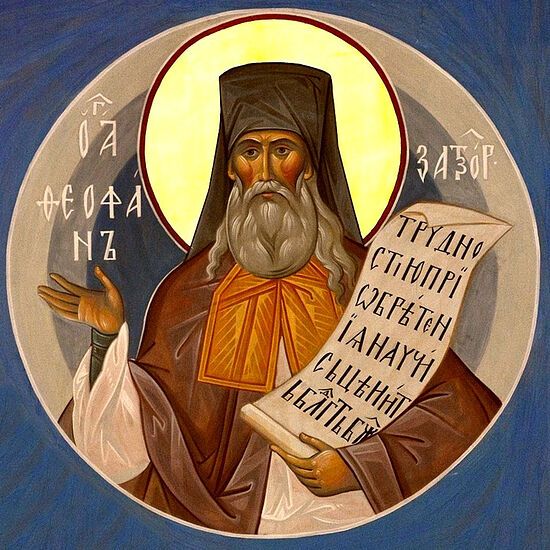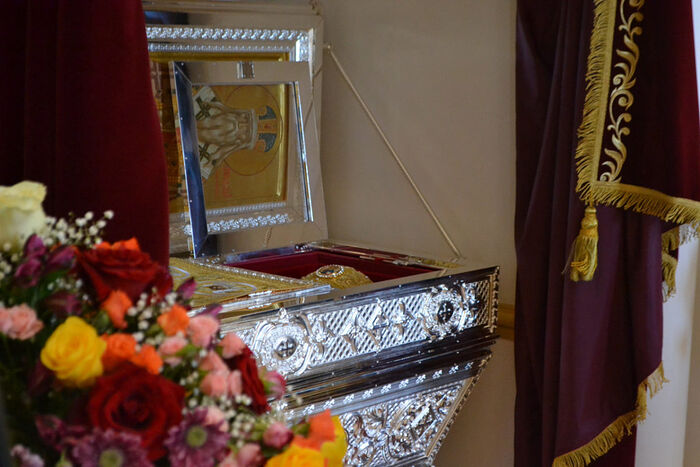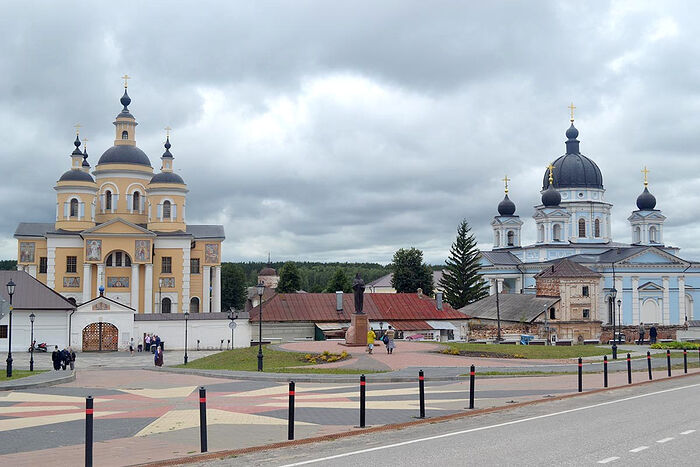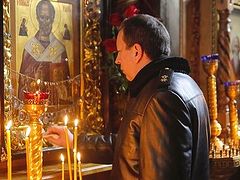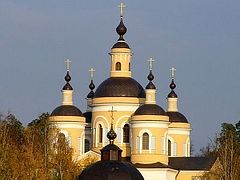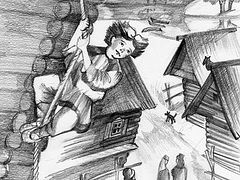The main miracle worked in the Church of Christ is the union of man with God and the rebirth of fallen human nature for the eternal and blessed life in the Kingdom of Heaven. In this sense, great teachers of the spiritual life such as St. Theophan the Recluse are wonderworkers in the truest sense.
Archimandrite George (Tertishnikov) writes about this:
“His Grace Bishop Theophan saved many from spiritual death by his letters, revived many for a new life, directed many on the path of truth, and indicated to all effective means for moral refinement.”
The Lord called St. Theophan to His Heavenly habitations on January 19, 1884, on the feast of Theophany—the feast he was named after when he took his monastic vows. Eyewitnesses recalled that when they vested him in his hierarchical vestments, a smile clearly shone on his face for all to see.
“For three days his body stood in the house church, and another three in the monastery cathedral, and no corruption touched it: The deceased had the appearance of someone calmly sleeping.”
Even during the earthly life of the Vysha ascetic, many people were confident in his holiness. This was confirmed by the grace-filled effect of his books and his many years of prayerful labor in reclusion. In a conversation with his disciples, the venerable Elder Barsanuphius of Optina said of St. Theophan:
“We all firmly believe that the Lord received his pure soul into His Heavenly Kingdom.”
The simple people affectionately called the Holy Hierarch “Batiushka Fr. Theophan.”
Before the revolution, his portrait could often be seen next to the icons in peasant homes. His name came second in the remembrance of Tambov residents only after the Venerable Seraphim of Sarov, who was not yet canonized at that time.
People often asked Abbot Arkady (Chestonov) of the Vysha Hermitage about the miracles that had occurred at Vladyka’s grave. And indeed, there were wondrous signs.
Shortly after St. Theophan departed to the Lord in Shatsk, the wife of one prominent official, the Minister of Finance, was widowed.
“My husband and I lived together in perfect harmony for nearly thirty years, and it was hard for me to lose him,” she said. “I was suffering from melancholy, which gave me nervous spasms in my throat that were choking me. Life itself seemed like a burden to me. I asked many people to pray for me. And then, in one blessed moment, before an icon of the Queen of Heaven, I entreated her to instruct me what to do to ease my soul from such excessive sadness.
“As if in response to this plea, I heard a quiet voice from the icon, half-whispering: ‘You must serve a panikhida at the grave of the bishop-recluse.’ I thought of Vladyka Theophan, and the thought had barely flashed through my mind: ‘Do you mean him?’ Then I heard the voice firmly say with special emphasis, right into my ear: ‘Yes!’ Having decided to fulfill the command of the Lord as soon as possible, I began to feel much better.
“When I arrived at the Vysha Hermitage, I did what I was told with great joy, and since then, I haven’t been attacked by melancholy even once. Now I find great comfort in prayer.”
In May 1904, Hieromonk N. of the Vysha Hermitage, fulfilling the obedience of chronicler, bore witness to the miraculous healing of an eye disease at the burial site of St. Theophan the Recluse. Here is the story:
“A peasant woman from the village of Saltykovy Buty in the Spassky District came to Vysha with diseased eyes, nearly blind, and after Liturgy she wanted to order a panikhida at the grave of Bishop Theophan. As the hieromonk scheduled to serve, I served the memorial service she ordered.
“Interested in her story, I asked the woman how she knew the name of Bishop Theophan and why she ordered the panikihda. The woman answered that she had been suffering from a serious eye disease for a long time. She was treated by a doctor, but it didn’t help. She would often pray at night for a long time, entreating the Lord for healing. During one of these nighttime prayers, a monk appeared to her and told her to go to the Holy Dormition-Vysha Hermitage and have a panikhida at the grave of Bishop Theophan. The vision was repeated twice more, and she came to Vysha.
“After several days in fervent prayer during the services, the woman returned home healed.”
And in June of the same year, the abbess of one of the monasteries of Kostroma visited the Vysha Hermitage. Having spoken with the pilgrim, Hieromonk N. learned that she had great veneration for St. Theophan. She had received several letters from him during his lifetime resolving doubtful and perplexing questions for her, and after his death, she prayerfully turned to him for help and advice in all difficult situations. Not long before her arrival, the saint appeared and commanded her to go pray fervently at Vysha.
In 1909, the future Hieromartyr Vladyka Kirill (Smirnov), then the bishop of Tambov and Shatsk, introduced the custom of annual memorial Liturgies on the days of the as-yet not canonized Sts. John of Kronstadt, Theophan the Recluse, Pitirim of Tambov, and Ambrose of Optina. On these days, all the Tambov clergy would serve a panikhida together for the repose of these wonderful ascetics of piety, which testified to the people’s belief in their glorification in the Heavenly Church and their future glorification on earth.
These beliefs were fulfilled by the words of Bishop Zinovy (Drozdov) of Kozlov, who in 1915 led the celebrations at Vysha dedicated to the centenary of the birth of the saint. After the Divine Liturgy, Vladyka Zinovy said:
“Blessed are you, brethren, that you can fall down at the tomb of St. Theophan and entreat his holy prayers and intercession before the throne of the Most High for us sinners. He is our guiding star! Let us imitate him as far as our weakness will allow.”
Soon after the revolution, the Vysha Monastery was destroyed. In 1923, the atheists expelled the inhabitants of the hermitage, many of whom later endured a martyr’s death. It was forbidden to celebrate the Divine services in the Kazan Cathedral where St. Theophan was buried, and in the 1930s, the Cathedral of the Nativity of Christ was closed. Then the mentally ill were transferred to the monastery, and a psychiatric ward was organized on the very place where the Vysha recluse had labored. And the long decades of godlessness dragged on.
One case of the saint’s prayerful patronage from the years of persecution was told by Irina Vladimirovna Danilova—the great-granddaughter of St. Theophan’s own brother—Vasily Govorova. Her grandfather, Theophan Grigorievich SIlvestrov, was the son of a priest.
“He was exiled to Karaganda for his Orthodox faith. When his sentence was up, he was left to work there. One day during a winter blizzard he got lost, having lost track of the road. Then suddenly he saw a bright figure in white episcopal vestments beckoning to him. He went to meet him, but the figure backed away and then disappeared, but Theophan found himself standing on the road.”
Unusual things would happen in the buildings of the ruined Vysha Hermitage. The locals said that sometimes the lampadas would light themselves in the ruined church, and singing could be heard. The doctor of the hospital, Ksenia Ivanovna, told Fr. George Glazunov how she witnessed this one night when she was on duty:
“They also say that when there was a kindergarten there, an elder would come in the morning with a towel on his shoulders [obviously, this is how the nurses described the episcopal omophorion—A. P.]. No one saw where he came from or where he went. He would come and tell the nurses: ‘Get out of here! You don’t belong here!’ And then he would leave, though no one saw where to.”
In the early 1970s, with the blessing of Archimandrite Kirill (Pavlov), the spiritual father of the Holy Trinity-St. Sergius Lavra, and under the direction of the head of the Church-Archaeology Department of the Moscow Theological Academy Igumen Mark (Lozinsky), the relics of St. Theophan the Recluse were secretly uncovered in the Vysha Hermitage’s ruined Kazan Cathedral. Hieromonk Elevthery (Didenko) and Fr. George Glazunov removed the relics from the broken tomb and they were taken to the Lavra and placed in the All Saints’ Church in the basement of the Dormition Cathedral.
In 1988, on the eve of the canonization of St. Theophan, Archbishop Simon (Novikov) of Ryazan and Kasimov blessed the building of a chapel in the St. Sergius Church in the village of Emmanuilovka, near Vysha Monastery, where the holy relics were then transferred from the Lavra. They remained in Emmanuilovka for fourteen years, during which time there were many testimonies of miracles. The rector of the church, Archpriest George Glazunov, testifies:
“There was a boy who hadn’t been able to walk since he was born. They brought him here three times from pretty far away. I laid him directly on the relics, like a baby, although he was two and a half. His parents first dipped him in the St. Theophan spring, then they brought him, and I placed him on the relics.
“And when they brought him the third time, during a service he asked to be put down on the floor, and he started running. My matushka was there and I was serving. The people were getting angry, because the boy was running joyfully and supposedly preventing them from praying. They told his mother: ‘Why don’t you take your child? He’s running around the church, interrupting our prayer!” And she just stood weeping from joy, unable to say anything. He’d never even walked, and now he was running!”
One day, some pilgrims came to Emmanuilovka with a woman who had a herniated disc, who should have been officially considered disabled. Having immersed herself in the St. Theophan spring, the pain in her back suddenly disappeared. She returned home and had a CT scan, and the doctor told her: “You don’t have a hernia anymore.”
Another time, a military pilot from Volgograd came, suffering from chronic sciatica. He had wasted a ton of money on treatments, but nothing helped. Having jumped in the spring, he could feel that the pain had completely disappeared. A year later, he came to thank the saint for his healing.
An unusual case of the intercession of St. Theophan also occurred in the life of his great-great-grand niece Irina Vladimirovna Danilova (Silvestrova):
“During a time of great grief, when her husband was in serious condition after a car accident and Irina was pregnant with their third child, the saint appeared to her in a dream in white vestments and reassured her that everything would be fine. He also predicted the birth of a son.”
In 1990, the cathedrals of the ruined Vysha Hermitage were returned to the Russian Orthodox Church, but it was another twelve years before the Vysha recluse returned with his holy relics to his beloved monastery, which he called “Paradise.” The celebration of the transfer of the relics from the St. Sergius Church in Emmanuilovka to Vysha, which took place on the eve of the Feast of All Saints, was headed by the ever-memorable Patriarch Alexei II.
Grace-filled help is given by the holy relics of this great teacher of the Russian Church.
“It’s commonly believed that St. Theophan was not a wonderworker. But in fact, he has worked and still works healings,” Mother Barbara (Znamenskaya) said in an interview to the journal Russian Monk. “There’s one woman who was working in the library, but now works in the local history museum. She asked that they bring spiritual brochures to the library for children to read. Besides the books, they also brought her oil from St. Theophan. She had eczema on her arms. She anointed them with the oil, and after a while, the problem went away.”
Another pregnant woman's baby was in the wrong position, and the doctors were preparing the mother for surgery. She wasn’t an active believer, but they persuaded her to put a handkerchief smeared with oil from St. Theophan on her stomach. Two weeks later, she went to see the doctor. To her great surprise, they told her the baby had turned over. She safely gave birth to a boy, and we baptized him at the monastery. This is how St. Theophan inconspicuously helps people. Some come to venerate his relics, others receive oil from the lampada over his relics, some put notes under his relics with a request for help in some matter, and others write notes of gratitude to St. Theophan.
Asked whether the sisters feel a closeness to St. Theophan, Matushka Barbara replied:
We’re not looking for any miracles. We just pray to him throughout the day. After evening prayers, we read the Akathist to St. Theophan. And we seek his blessing for everything. The day’s begun—get a blessing; the day’s come to an end—get a blessing. And if you don’t get a blessing, everything will go wrong that day; you won’t be able to get anything done. But if you get a blessing, everything goes smoothly, as it should. For example, one time one sister had to leave unexpectedly, which meant that not all the obediences would be fulfilled—there was no one to wash the dishes. We went and asked: “Holy Hierarch Fr. Theophan, help. What should we do?” Just then a woman came, saying: “I’d like to stay with you for a week.” And as soon as the pilgrim left, the sister returned. Here’s another story: There was no one to cook—everyone was busy at other obediences. We asked the Mother of God and St. Theophan for help. Then a pilgrim came who could help the sisters by doing the cooking. So look: Is this a miracle or not?
In 2010, some pilgrims came to Vysha Monastery from Dnepropetrovsk, including a mother with a six-year-old daughter who simply couldn’t learn to read. She would pronounce the letters, but the words wouldn’t come together for her. It was her birthday, and her mother asked with simplicity, “St. Theophan, what will you give my daughter?” After venerating the saint’s relics and returning to the bus, the girl picked up the children’s Gospel from one of the seats and started reading. This was witnessed by the Vysha sisters.
Since 2011, the Kazan Vysha Icon of the Most Holy Theotokos and a reliquary with a particle of the relics of St. Theophan have been taken in procession to many dioceses of Russia and neighboring states. Many people come from all over to venerate them. God reveals special signs of His mercy. On August 6, 2011, the relics of St. Theophan were greeted in Kiev, about which the saint himself had written after going into reclusion: “Kiev is a precious place. How I would like to visit it!”
The icon of the Queen of Heaven and the relics of the saint were placed in the Church of the Elevation of the Cross of the Lord at the Kiev Caves Lavra. Suddenly there was a sweet fragrance, very clear, seeming to emanate from the reliquary. It was first noticed by the abbot of the Lavra, Metropolitan Pavel (Lebed) of Vyshgorod and Chernobyl. The fragrance was repeated in western Ukraine too, at the Pochaev Lavra.
According to your faith be it unto you (Mt. 9:29), the Lord Jesus Christ said to the blind man who asked for his sight. And so the miracles performed by the prayers of His faithful follower St. Theophan strengthen our faith in the fact that the grace of God abides in the Church of Christ and in our souls. Whether we receive grace-filled help depends solely on our Orthodox faith, which we should ignite from beacons such as St. Theophan.

